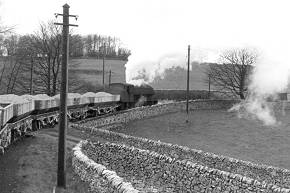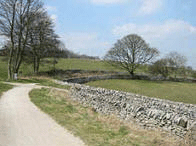
Joseph Roe 1775, one of the youngest children of John and Ellen married Elizabeth and they had
four children.

Mary, John and Ellen's eldest daughter married William Evans at Snelston
in 1781 and they had four children. One, Mary Ann Evans married Sampson
Stubbs in 1826 at Hanley, Staffordshire. Sampson is possibly related to
my ancestor, Sampson Stubbes since Sampson the younger was also from
Butterton. Sampson and Mary had four children.
Thomas Roe 1768, a son of John and Ellen Roe married Margaret
Stubbs on 4 February 1789 at Snelston.

Another son of John and Ellen, William Roe 1759 married Frances Milner
on 2 July 1789 at Snelston and they had seven children.

John Roe 1794 married Margaret Finney at Ellastone in 1815.
William 1799
married Elizabeth Goodhall in 1825 at Bradley and they had two daughters
at Bradley, Emma Roe 1829 and Sebra Roe in 1832.

Maria Roe married Michael Coxon in 1822 at Norbury and Roston and they
had four children. One child, William Coxon married Julia Oliver and
they had four children in
Birmingham.
Thomas Roe 1806 married Elizabeth Kirkland at Ashbourne in 1825 and they
had five children.

George Roe 1825 married Harriet Storer on 10 November 1861 at Mickleover,
Derbyshire and they had five children.

One son, Thomas born c1869
married Emily who was from Dudley and they had two children in
Whitehaven, Cumberland,

Thomas
was a grocer. Another son of George and Harriet, William Arthur Roe
1870, married and in 1901 was a gas fitter in Bristol.
The youngest child of William Roe and Francis Milner, George was
born in 1810 at Snelston. George married Hannah Dakin on 18 February
1830 at Snelston and they had nine children.

Hannah Roe married James Renshaw in 1864 at Snelston and they had three
children.

Frances Roe had two children, Noah Roe in 1865 and Abraham Roe in
1875.

Margaret Roe had
a son Robert Roe in 1866. Robert went on to marry Hannah Wibberley at
Ashbourne in 1888 and they had five children in Ashbourne. Margaret
married Moses Grindey and they had nine children.
William Roe, George and Hannah's eldest son married Elizabeth
Fearn and they had five children.

George Roe and Hannah's second son, George married Elizabeth Hampson in
1854 at Snelston and they had four children at Snelston.

John Roe, George and Hannah's third son married Sarah Fearn the
sister of William's wife and they had three children.

Going back to John and Ellen Roe at the top of the Snelston Roes, they
had a son, Edward baptised at Snelston on 23 March 1768. Edward married
Sarah Redfern on 20 November 1787 at Norbury and Roscoe. They had seven
children

Samuel Roe 1797 married
Elizabeth
and they had two children, Mariah and Charles. Charles later married and
had two children of his own, Arthur Herbert Roe in 1870 at Branstone,
Staffordshire and Charles Henry Roe in 1876 at
Burton
under Needwood, Staffordshire.
Fanny Roe had a son,
Jesse born at Snelston. Jesse married
Elizabeth
and they had five children, Jesse W, Henry, Joseph A, Lizzie and Arthur.
All were born at Marchington, Staffordshire. Joseph married Florence
Reeve in 1896 at Burton upon Trent and they had two children, Arthur and Florence.
James Roe, Edward and Sarah's youngest son married Ann and they
had eight children in Snelston.

Ann 1827 had a son, Ralph Roe in 1850 at Snelston.
James 1829 married Sarah Bowen and they had a daughter, Agnes Alice Roe
in 1851 at Ashbourne.
Samuel Roe 1835 married Catherine who was born in
Ireland
and they had six children at Snelston, Ann, Elizabeth, Catherine, Jane, Sarah and Rosey.
Henry Roe 1839, married Mary Ann Taylor and they had ten children at
Snelston.

Some of these children married and had families including a Henry Roe
1873 who married Mary from Liverpool at Sheffield in 1896, had a
daughter, Violet Mary Roe in 1898 at Sheffield and then the family
emigrated to America
sometime after 1901 when they were living at Hoylake on the Wirral.
Going back to Edward Roe and Sarah Redfern, they had a son Edward Roe
born in 1793 at Snelston. Edward married Hannah Wybberley on 23 December
1813 at Snelston and they had five children.

Anthony Roe 1832 married Elizabeth Swinger on 24 June 1878 at the
Church
of St Edmund with
Marshall, Caistor,
Norfolk
and they had a daughter, Jane Roe.
Edward Roe 1826 married Harriet Smith in 1849 at Doveridge, Derbyshire.

Ralph married Louisa Hall and they had a daughter, Isabella Roe in about
1870 at Oakamoor, Staffordshire.

Ambrose married Sarah and they had six
children in Derby.

Enoch Roe 1816 married Elizabeth Adams on 21 May 1836 at Ashbourne and
they had seven children.

Thomas James Roe c1841 married Rebecca Shaw in 1864 at Snelston and they
had six children.

Louisa, who was born in 1875 at Wyaston, married Joseph Frederick
Spencer in 1896 at Derby and they had four children. I have been
in contact with Brian Wilson, born in 1937 at Ashbourne who is descended
from one of Louisa and Joseph's children, Amy Spencer.
Julia Roe 1848 had a son Thomas Archer Roe in 1867 at
Alton Towers, Staffordshire. Julia later
married John Warrington in 1870 at
Alton
and Thomas was brought up by John as his own. They had five other
children at Farley, Staffordshire.
Thomas Archer Roe 1867 married Mary Ann Ufton at Shardlow, Derbyshire in
1892. They had five children.
family tree
I would like to thank Judith Stubley (pictured below, pink scarf), a
grand-daughter of Thomas Archer Roe who gave me information on this
branch of the family including correcting some of my mistakes. Judith is
standing outside the cottage at Cackle Hill, Snelston believed to be
where Enoch Roe and his wife lived. Judith is talking to Susan Parsons,
the owner.
|
















